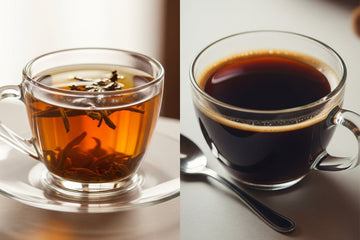Coffee and tea are two of the world's most popular beverages, each offering unique flavors, aromas, and health benefits. But how do they compare in terms of caffeine content and Total Dissolved Solids (TDS)? Understanding these differences can help you choose the right drink for your energy needs and taste preferences.
1. Caffeine Content: Coffee vs. Tea
Here’s a quick comparison:
|
Beverage |
Caffeine per 8 oz cup (approx.) |
|
Brewed Coffee |
80–120 mg |
|
Espresso (1 oz) |
60–70 mg |
|
Black Tea |
40–70 mg |
|
Green Tea |
20–45 mg |
|
Oolong Tea |
30-50 mg |
|
White Tea |
15-30 mg |
|
Herbal Tea |
0 mg |
Why the difference?
- Coffee beans contain more caffeine per gram than tea leaves
- Coffee Bean Type - Robusta has nearly double Arabica's caffeine
- Tea Leaf Age - Young leaves (matcha) contain more caffeine
- Brewing Time & Temperature - Longer extraction more caffeine
2. TDS: The Science of Strength
TDS (Total Dissolved Solids) measures how much of the coffee or tea ends up dissolved in your cup — things like oils, acids, and caffeine.
|
Beverage |
Typical TDS (%) |
|
Espresso |
8–12% |
|
Brewed Coffee |
1.15–1.35% |
|
Black Tea |
0.8–1.2% |
|
Green Tea |
0.5–0.8% |
What TDS tells you:
- Higher TDS = bolder, richer taste.
- Lower TDS = lighter, more delicate flavor.
- TDS also correlates with mouthfeel and perceived strength.
This is why espresso, despite being served in small amounts, tastes stronger than a large cup of green tea — it's much more concentrated.
Key Influences on TDS:
Extraction Method (Espresso vs. Cold Brew)
Brewing Time & Temperature
Grind Size (Coffee) / Leaf Grade (Tea)
3. Which Is Better for You?
Choose Coffee If You…
- Need a strong caffeine boost (e.g., morning energy).
- Prefer bold, intense flavors (high TDS).
- Enjoy espresso-based drinks (latte, cappuccino).
*High doses of caffeine can increase anxiety in sensitive individuals.)
Choose Tea If You…
Want moderate caffeine with calming L-theanine (less jitters).
Prefer lighter, more varied flavors (low to medium TDS).
Seek antioxidant benefits (green tea EGCG, black tea theaflavins).
Final Thoughts
Understanding the difference in caffeine and TDS between coffee and tea can help you make smarter, more personalized choices. Whether you're brewing at home or ordering at your favorite café, now you know how to match your drink to your energy needs and taste preferences.
Looking to upgrade your brewing game?
Explore our precision coffee machines/grinders and tea makers designed to bring out the best in every cup — from bold espresso to refreshing tea.






